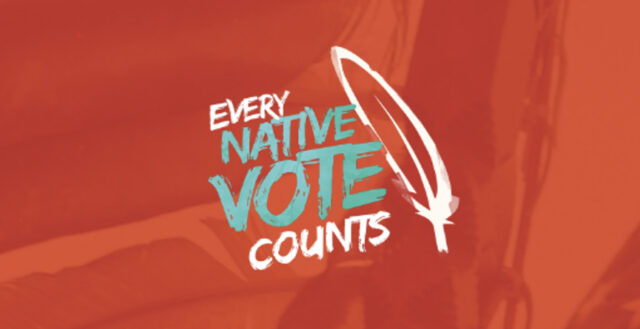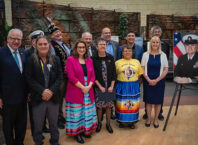By Ximena Bustillo/NPR
Grassroots efforts to get Native American voters to turn in their ballots for the 2024 election are in motion across swing states as Democrats and Republicans are both vying for power.
There are predicted to be at least 5 million Native and Alaska Native-identifying voters in the U.S. in both rural and urban communities, according to the U.S. Census Bureau – although estimates are expected to be an undercount.
“Native Americans are incredibly influential and have the ability to really swing those elections on the margins,” said Jacqueline De León, a senior staff attorney at the Native American Rights Fund, adding that she sees the potential for Native voters to decide elections where the population of Native Americans is bigger than the vote differentials that decide those races.
There are some challenges ahead. Native voting activists have filed several lawsuits, aimed at challenging laws and efforts that would limit access to voting for Indigenous people, De León said. These include laws that limit poll availability, identification card barriers, and issues with mail-in ballots on reservations.
Hanging in the balance is control of House, Senate and the Oval Office in 2024. In a country in which turnout can make or break campaigns, organizers said courting Native voters can dictate a candidate’s success. Organizers argue Native voters are increasingly a coalition to watch.
“Both political parties have been really negligent when it comes to the Native American vote,” De León said. “Often there is an unfamiliarity. There’s a fear of approaching Native communities that may seem unapproachable or there’s uncertainty over how to approach Native communities. And so there just hasn’t been an investment.”
Those who have been successful, advocates said, are those who use traditional organizing and voter mobilization tactics, especially among the rural Native coalitions.
“Rural America broadly, but especially rural Indian country, still operates on very importantly, on relationships, on handshakes… And that’s that’s how voters gain confidence, either in an individual running or a ballot initiative or any sort of change to policy or election requires that kind of investment in it,” said Ta’jin Perez, deputy director for Western Native Voice.
States where Native voters could have a significant impact on 2024 races for Congress, Senate and for president:
•Alaska is home to over 200 federally and non-federally recognized tribes, with American Indian and Alaskan Natives making up at least 22% of the state’s population. The communities have been credited with helping Republican Sen. Lisa Murkowski, and Democrat Rep. Mary Peltola win their respective elections, according to the Native American Rights Fund’s De León.
The Native American Rights Fund has pending litigation in Alaska, however, that alleges ballots coming from Alaska Native communities are rejected at much higher rates than other communities.
“When you have a flux of political power, we usually also see a corresponding backlash that makes attempts to make it more difficult to vote as well,” she explained of the legal action, De León said.
• Arizona has 22 federally recognized Native nations within its borders. The U.S. Census estimates that more than 6% of the state’s population identifies as American Indian or Alaska Native. In a swing state, like Arizona, where only a few thousand votes can make the difference, voting advocates say political parties need to recognize Native voters’ power.
Voter turnout on tribal lands in Arizona helped President Biden secure a win in 2020, the first Democrat to win the state in more than two decades. Native Americans also turned out in large numbers during the 2022 midterms, according to Castillo-Nunez, helping Democratic Gov. Katie Hobbs secure a win.
• Michigan flipped from Donald Trump to Biden in 2020. Native voting advocates said that Indigenous turnout is what helped strengthen Democratic strongholds. The Native American Rights Fund argues that with more than 100,000 Native people eligible to vote, the population is four times the size of the margin of victory for Trump in the 2016 election.
Tori McGeshick, the first Indigenous organizer for We the People Michigan Action Fund, has been working to connect Indigenous communities with politics. She sees outreach to Native communities as a continual work in progress, even for her organization.
“A lot of times Indigenous peoples just don’t have the means to get out and vote, whether it be transportation or being able to get an ID, and then not to mention we’re also in a very rural area. So when people are expected to travel, it’s not like it’s just down the road,” McGeshick said, adding that she has done a lot of tabling at powwows and local grocery stores.
• Montana is estimated to have a population of more than 1 million people. Just over 9% of the state identifies as American Indian or Alaska Native. While Montana is considered a Republican stronghold for the presidential race, voters in the state will be facing a potential swing election in the race for the Senate.
Incumbent Democrat Sen. John Tester thanked Native voters for helping him win in 2018.
“Last time Senator Tester ran for the Senate, his election was secure because of the Native vote,” said Perez of Western Native Voice out of Billings, Mont. “On election night, before I went to bed and before all of the Native precincts started reporting fully, it looked like a loss for for Tester. But by morning, after the Native precincts reported completely the victory was Tester’s.”
Western Native Voice, according to Perez, is already working on voter registration efforts — initiatives they usually don’t begin this far ahead of an election.
The key here, he said, is turnout and making sure that candidates and parties make a direct connection with voters and inform voters of upcoming elections.
• Nevada has more than 62,000 Indigenous people living in it, which generally account for 3.5% of the state’s population, have been credited with helping Democrats secure wins in recent elections.
“We know that Native American voters in what is now the state of Nevada are voting in bigger numbers,” said Stacey Montooth, executive director of the Nevada Indian Commission, a state agency. “There are thousands and thousands of Native Americans who want to be involved in the process.”
Montooth said, as a result of lawsuits, there are services in the state that make it easier for Indigenous voters to vote including laws requiring any voting services available to Nevadans generally be available on tribal land as well.
All Voting is Local, a voting rights group with a Nevada chapter, pointed to an increase in Native American turnout rates in 2020 compared to 2016 as a reason why mail-in ballot efforts from the pandemic should be expanded and made permanent. The measure was passed ahead of the 2022 midterm elections.
• North Carolina has around 3% of its population identifying as Native American or Alaska Native. That includes the Lumbee Tribe, which is state recognized but, unlike 574 tribes across the country, is not fully federally recognized. The tribe, concentrated in the southeast portion of the North Carolina around Robeson County, has notably grown more conservative in recent presidential elections, voting Democrat until 2016, when it flipped for Trump, who supported its federal recognition.
“North Carolina has a very active Native caucus that’s a very large Native electorate,” said Judith LeBlanc, executive director of the Native Organizers Alliance, adding that while Indigenous voters could trend Democrat, they also will vote Republican.
President Biden’s campaign is already investing in the state generally, three years after he lost it by just under 75,000 votes. Some say that the Democratic party took the Native vote for granted in the last election.
The only federally recognized tribe within North Carolina is the Eastern Band of Cherokees, with about 16,000 members. Although the district where the tribe is located is primarily Republican, tribal members have also been known to vote for Democrats.
• Wisconsin is another key state that helped deliver Biden a win after voting for Trump in 2016. There, 2.5% of the population identifies as American Indian or Alaska Native.
Wisconsin Native voters, like in other aforementioned states, are credited with helping deliver Biden a win in 2020 along tight margins.
Dee Sweet, manager for Wisconsin Native Vote, boasts increasing voter turnout across the 11 federally recognized tribes in the state and said she noticed an increased interest in the electoral process.
Organizers point to Wisconsin, as well as other midwestern swing states like Michigan, as a place where political parties need to recognize urban Native voters in addition to rural voters.







